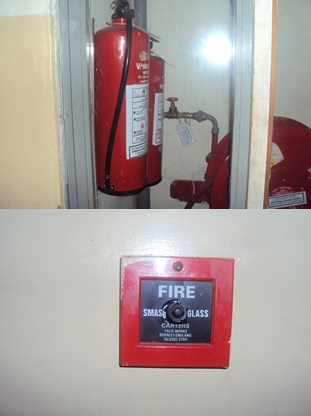Table of Contents
- Introduction
- Building/ runway Management and Security System
- Environmental impacts
- Public participation
- Conclusions
- Bibliography
Introduction
Environment under which the new creator would not jeopardize potential generations’ opportunity to enjoy the same opportunities. This study includes undertaking an environmental impact assessment (EIA) on the possible improvements or expansion of Pembrey Airport, with an emphasis on the potential for fires in the current freight and customs warehouse, as well as on the runway (Morgan, 2000). The study includes, among other items, the project summary, the site’s current environmental condition, the possible positive and negative environmental effects, mitigating strategies, and environmental regulations pertaining to fire safety in such projects.
The proposal was analyzed by the EIA team using a number of tools, including field assessments, questionnaires, and interviews with neighbors. There was also a study of current literature on regulatory and other criteria (Wood, 2003). Various Acts and Laws were analyzed during the analysis to collect knowledge that would assist in the training of EMPs. The following baseline data are obtained from the planned project’s assessment:
- The project is being built in a well-known commercial area.
- Following public consultations, it was discovered that the scheme has no major detrimental environmental consequences.
- Since the project
- entails the management of socioeconomic consequences, a comprehensive EMP is needed.
- The project has tremendous socioeconomic and economic
value, as well as the ability to create jobs.
The Environmental Impact Assessment Study for the planned runway expansion at Pembrey Airport is included in this report. Carmarthenshire County Council, the project’s proponent, appointed an environmental team to perform an EIA review of the new development’s fire danger during the implementation and operating processes. The planned location is close to leisure areas such as the Ffos Las racetrack and the Machynys Championship golf course. Pembrey Airport is 11.8 kilometers north of Llanelli and 17.9 kilometers south of Carmarthen. The facility is used for a variety of uses, including preparation, freight loading and offloading, landings, and take-offs. It’s just a few kilometers from the Royal landing base, but far enough away to be secure. The customer in this situation wished to increase the runway duration to 2400 meters (7.874 ft).
The Air Bus A320 commuter plane, VIP business planes, and horse/race car transporting freighters would all be able to travel as a result of this. Furthermore, the promoter wants the facility to be able to handle huge combat aircraft like the C130, which would be used for both logistics monitoring and preparation. In addition to the runway, the proponent, Carmarthenshire County Council, wants to optimize the facility’s capacity by recommending the creation of a modern airport, customs, and freight facilities. The Welsh government lawmakers are excited regarding the new construction since it would support the Carmarthenshire area and represent both the southern and western sections of Wales. This will boost the aviation industry in Wales and the surrounding areas.
The operational phase of the project will involve offering spacious and modern freight office spaces and runways among others. Main inputs will be basic services such as electricity, emergency services, degradable and non-degradable goods, etc. Key outputs of the project will include degradable and non-solid wastes from construction materials. This may include plastics, metal chips, and waste electric cables among other materials in fireworks (Morris, 2001). Decommissioning phase will consider restoring the site to its nearest original built status if necessary. The operational phase will employ widely accepted fire hazard strategies such as low/recommended volume of electricity voltages, protective clothing when workers on duty, use of signs to warn workers of dangerous zones, escape openings in case of accidental fires, training staff on disaster preparedness and response strategies, installing and offering appropriate trainings on fire extinguishers within the facility and instalment of fire sensors among others. Project description
This describes all major works associated with power connections in the proposed project.
Power Supply
Incoming Supply:
Electrical power supply will be derived from the existing local power supply company and networked to the developed areas. Electricity will provide light energy during both implementation and operational phases of the proposed project. The power will also be used to drive the machineries in the newly constructed warehouses and power the digital sensors that will be installed in the new terminals and buildings among other purposes of electricity. The proponent will contract experienced electric firm to conduct all the connection firms to limit chances of electrical accidents.
Power Distribution:
Power derived from the closest transformers will be connected to the main electrical switchboard. From the main switchboard power will be distributed to the proposed buildings among other construction areas as indicated in the proposed project. This would be conducted through armored cables run in ducts and vertically through riser ducts in the construction areas. Power will also be distributed horizontally within the suspended ceilings. However, the relevant contracted firms would produce a comprehensive report of their works to enable the proponent make recommendations or adjustments to match the financial budget of the entire project. Furthermore, the proponent or the company will mobilise its internal electrical specialist to supervise all the electrical works in the proposed project.
Power Outlets:
Power outlets (plug points) will be provided at all the construction sites. These shall derive power from the distribution boards or consumer units. The conduit system for the power outlets shall be heavy gauge PVC type concealed in the building fabric. The wiring will be by PVC cables run in the concealed conduits.
Lighting Installation
The connections for the lighting installation will consist of PVC insulated/coated cables which run in conduits concealed in the building fabric. Compact fluorescent and down lighters with energy saving lamps will be installed in the circulation areas and washrooms. The public areas will also be provided with energy saving lamps for ceiling mounted, suspended and wall mounted lights.
Lighting sensors shall also be installed in public areas to switch lights off automatically during long periods of non-occupancy as an energy saving measure. The external areas will be lit by weatherproof lighting (Hirschler, 2002). These shall be either wall or pole mounted to suit their location. Security lighting will be controlled by photocells, which will switch them on and off automatically. There shall also be overridden switches to the photocell units should it be necessary to put the lights on at other times.
Fire Alarm System
An electrical fire alarm system shall be installed in its control and indicator panel suitably located on the ground floor with a repeater panel in the manager’s and security officer’s offices. The alarm system will be activated in the event of a fire breaking out in any part of the building. The alarm can be raised by an observer breaking glass of the nearest contact or by smoke or heat detector being activated. As a result of activation, fire alarm bells will ring and the location of the fire will be displayed at the control panel on the necessary action to be taken. Smoke detectors will be installed in the passageways, offices and plant rooms (Thompson, 2001). The fire alarm system shall be the addressable system type allowing for the exact location of the fire to be displayed on a monitor. The fire alarm system will also be linked to the security system.
Building/ Runway Management and Security System
All the building/runway equipment will be connected to a central monitoring system, from where the whole system would be controlled. However, the connections could also be done to the existing control room, depending on its ability to handle more connections. This equipment is made of pumps, fire fighting/metering equipment, automatic water sprinklers in case of accidental fires among others. Considerations will be made for microwave detectors used to switch lights on/off in response to occurrence in the circulation areas. Furthermore, special equipment will be installed to monitor/control the use of natural light when sufficient natural light is available, especially in circulation areas; this would help conserve the energy. A security system comprising of closed circuit television (CCTV) will be provided in management areas to enable security personnel monitor movement within the premises. The security alarm system will include a facility for calling for backup from designated security firms.
Standby Generator
A standby generator to provide electricity in times of power failure will be installed in the newly constructed sites to boost the existing one. The generator will have an automatic start arrangement for conveniences. The generator shall remain off when normal power is resumed and be ready for the next start when required.
Fire Fighting
The fire fighting equipment shall comprise of a sprinkler system in the public areas and corridors. Hose reels and portable fire extinguishers will also be provided within the building. The sprinkler system shall be activated by heat being sensed by the sprinkler head, which in its turn sets off the sprinkler pump. The hose reels on being opened will be pressured by a hose reel pump, and the nozzle would then be directed to extinguish the fire. The portable fire extinguishers will be of two types: one for normal fires and one for electric fires. Fire hydrants will also be suitably located around the building.


Pic. 1. Existing fire fighting measures
Environmental Impacts
Positive Impacts
Creation of Employment
The proposed project will provide a wide range of electrical works in the airport. This will include unskilled labor, consultants and electrical engineers among other specialist. This project would reduce poverty as per the millennium development goals, which regard poverty as serving on a daily budget less than a dollar. Furthermore, the project would ensure that the hired professionals and unskilled labor benefit during construction, operation/maintenance as well decommissioning phases.
Provision of Spacious Runway and Customs Warehouse and Offices
This will enable the facility to expand its operations by handling the Air Bus A320 Passenger aircraft, VIP corporate jets and military aircraft like C130. This would boost the company’s returns among other benefits. More operational spaces like the customs are more likely to increase productivity and the overall company turn out.
Business Booster Recreational Centers
Completion of the proposed project would ensure easy landing and boarding of tourists in the neighboring recreational facilities like Ffos Las racecourse, Jack Nicholas designed and Machynys championship golf course. This would boost their business since more tourists or recreational clients prefer destinations with advanced transport and communication systems.
Improved Disaster Management at the Airport
The installation of advanced fire alarms and fire sensors will limit the chances of fire accidents within the airport in general. The sensors will be installed in both the runway and newly constructed custom warehouse among other facilities. All workers will also be trained on how to use the sensors or alarms and avoid areas with such fires or dangers.
Negative Environmental Impacts
This explains some of the likely negative environmental impacts in all the phases of the project. These impacts will cover both the runway and custom warehouse.
Firebreak Outs
Accidental fires are likely to occur during the construction and operational phases of the project. This may result from faulty connections, inappropriate materials or components, excess power voltage transmissions, natural disasters like wind breaking electrical components, human ignorance, faulty planes, air buses or jets among other facilities supported by the runways and the head on collisions on the runway among other causes (Morr, 2006). These fires, if not well controlled or managed, may lead to loss of the company resources and even human life. Spillages of planes, jets among massive faulty facilities may spill their fuels on the runway. The volatile or flammable spills may cause fire break-out when sparked by cigarettes, sparks from fractioned metal parts or even sparks from open fires.
- Disruption of normal operations in the neighboring recreational facilities.
Both the construction and operation phases of the project are likely to have some negative implications for the operations in the neighborhood. The runway and customs operations may produce excessive noise beyond recommended decibels; this may cause some sense of discomfort in such areas. Tourists and other clients in the recreational facilities may opt to seek same services in more comfortable destinations. This may see closure of such facilities. Accidental fires may come with the general state of confusions in both the airport and its neighboring businesses.
Disruption in Power Supply
The construction and the operational phase of the project may lead to disruption of power supply at the airport as a whole and its surroundings. The mains may be switched off to limit chances of electrical accidents during constructions. This may limit surrounding establishes or businesses without standby generators. Furthermore, such disruptions may cause transmission of excess volts in the surrounding lines which may cause accidental fires or damage electrical appliances.
Mitigation Measures to the Negative Impacts
Mitigation Measures to Fire Outbreaks
The proponent would ensure he contracts experienced firms or individuals to conduct all critical installation works. Such firms should ensure they use the correct installation equipment as per the manufactures’ instructions. Recommended electricity voltages should be labelled on the machineries among other electrical appliances to guide the operators in the airport. Workers should be trained in disaster preparedness and responses to help limit the impacts of accidental fires within the premise. The proponent will ensure the project incorporates installation of working fire extinguishers in strategic corners in the establishment (Ashford, 2001). Furthermore, workers will be trained on the usage of such appliances. Fire detectors should also be installed in strategic positions within the airport. Such sensors should be able to commute responses to the central monitoring centers for appropriate actions to be taken.
Mitigation measures to the disruptions of normal operations in the neighbouring establishments
The proponent should fence the project sites to limit disturbances to the surrounding facilities. Such disturbances may result from noise and vibrations during the installation of electrical appliances and sparks metal works among others. Furthermore, the project should use environmentally friendly materials and coated alloys, which have limited sparks or vibrations. The neighboring establishes should be informed of ongoing works to prepare psychologically. The proponent should invest in sound proof and vibration materials in enclosing the construction site. This would absorb major disturbances to the neighbors.
Disruption of power supply
The proponent should inform its neighboring establishes on the ongoing works so that they can activate their standby generators in case the power supply is disrupted. Major electrical works should be conducted at night or during weekends when most establishes are closed. The proponent can make a special request to the local electricity distributing company to establish a subsidiary or alternative distribution line when the main lines are switched off while electrical works are underway. The company should also install standby generators to ensure other airport operations are not paralysed by construction works.
Public Participation
The key findings of the study were obtained from interview sessions by key individuals within the airport and its neighboring establishes. Some committed bodies or individuals were offered questionnaires to air their views, as far as the proposed project is concerned. They both mentioned the beneficial and negative implications of the proposed project. Some of their positive and negative verdicts are discussed above. However, there was no serious comment or negative impact that would hinder the implementation of the proposed project. The proponent committed that it would adhere to the provided environmental plan to ensure all the mitigation measures are observed.
Environmental management plan (EMP)
| Impact | Mitigation measures | Responsible party | Estimated Duration | Estimated cost($) | |
| Fire outbreaks | Installation of fire alarms and sensors
Provide disaster preparedness and response trainings |
Proponent/ contractor | 12 months | 850,000 | |
| Disruption of neighboring normal operations | Sound and vibrations proof fencing | Proponent/contractor | 12 months | 230,000 |
Table 1. Some of the areas the proponent will commit to ensure the success of the proposed project.
Conclusions
The above project would have more benefits compared to its negative environmental impacts. It would be the role of the proponent to ensure all the mitigations are observed for the benefit of the social and physical surroundings of the proposed project site. Otherwise, the environmental team would comment the project for implementation phase.
Bibliography
- Ashford, N. 2001. Airport operations. New York: McGraw Hill Education.
- Hirschler, M. 2002. Fire Hazard and Risk Assesment. London: ASTM international.
- Lawrence, D. 2003. Environmental Impact Assesment: practical solutions to recurrent problems. New York: John Wiley & Sons.
- Morgan, R. 2000. Environmental Impact Assesment: A methodological approach. New York: Springer.
- Morr, E. 2006. The protection guide to hazardious materials. New York: Pearson.
- Morris, P. 2001. Methods of Environmental Impact Assesment. New York: Taylor& Francis.
- Thompson, N. 2001. Fire Hazards in the Industry. New York: Elsevier.
- Wood, C. 2003. Environmental Impact Assesment. New York Prentice Hall.



